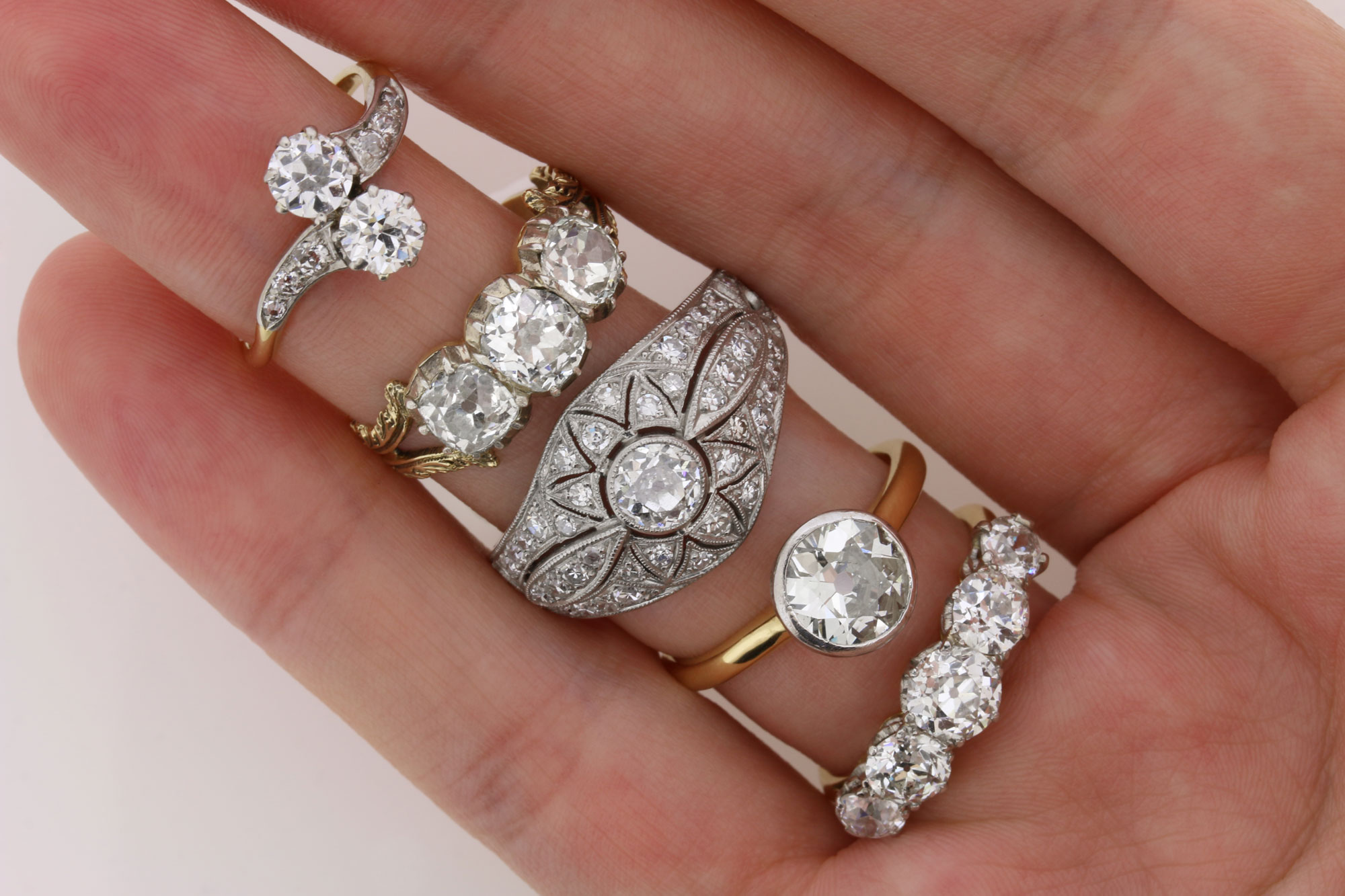This vintage diamond guide is your passport to the captivating world of antique and vintage jewellery. Each diamond cut featured here, from the Old Mine Cut to the Victorian cut, has a rich history and distinctive charm.
Peruzzi Cut Diamond:
The Peruzzi Cut Diamond is characterised by a squarish girdle and a high crown with triangular facets. It was developed in the 17th century and is considered one of the earliest brilliant cuts.
The Peruzzi Cut Diamond was prominent during the Renaissance period, known for its emphasis on symmetry and geometric designs. It was a favourite among European royalty and aristocracy, symbolising wealth and prestige.
Rose Cut Diamond:
The Rose Cut Diamond features a flat bottom with triangular facets arranged in a symmetrical pattern resembling the petals of a rose. It originated in the 16th century and is known for its simplistic yet elegant appearance.
The Rose Cut Diamond was popular during the Georgian and Victorian eras, where it was often used in intricate and romantic designs. Its popularity waned with the advent of more brilliant cuts in the 20th century but experienced a resurgence in modern vintage-inspired jewellery.
Pendeloque Cut Diamond:
The Pendeloque Cut Diamond, also known as the pear-shaped or teardrop cut, is characterised by a rounded end and a tapering point. It combines elements of the oval and marquise cuts.
The Pendeloque Cut Diamond gained popularity during the Georgian and early Victorian eras, favoured for its versatility in both solitaire and accent settings. Its elegant silhouette made it a popular choice for pendant necklaces and earrings.
French Cut Diamond:
The French Cut Diamond is a square or rectangular-shaped diamond with a faceted pavilion and a step-cut crown. It features a cross-shaped pattern on the crown facets, creating a distinctive sparkle.
The French Cut Diamond originated in the 18th century and experienced a resurgence during the Art Deco period of the 1920s and 1930s. It was favoured for its geometric precision and was often used in Art Deco-inspired jewellery designs.
Old Single Cut Diamond:
The Old Single Cut Diamond is one of the earliest diamond cuts, featuring a simple circular shape with a small table and a large culet. It has a vintage charm with a subtle sparkle.
The Old Single Cut Diamond was prominent during the Renaissance and Baroque periods, known for its simplicity and understated elegance. It was often used in antique jewellery designs, particularly during the 17th and 18th centuries.
Table Cut Diamond:
The Table Cut Diamond is characterised by a flat table facet and step-cut pavilion, creating a rectangular or square-shaped diamond. It has a sleek and angular appearance.
The Table Cut Diamond was popular during the Renaissance and Baroque periods, where it was often used in ornate and elaborate jewellery designs. It was favoured for its dramatic play of light and shadow, reflecting the opulence of the era.
Pointed Cut Diamond:
The Pointed Cut Diamond, also known as the pointed oval or navette cut, features a tapered oval shape with pointed ends. It combines the elongated silhouette of the marquise cut with the symmetry of the oval cut.
The Pointed Cut Diamond gained popularity during the Rococo period of the 18th century, favoured for its graceful and feminine appearance. It was often used in delicate and intricate jewellery designs, symbolising elegance and refinement.
The Old Mine Cut Diamond:
The Old Mine Cut Diamond is one of the earliest forms of diamond cutting, originating in the 18th century. It features a squarish or cushion-shaped outline with a high crown, small table, and large facets, resulting in a distinctive sparkle with broad flashes of light.
The Old Mine Cut Diamond was prominent during the Georgian and Victorian eras, from the early 1700s to the late 1800s. It was hand-cut with primitive techniques, giving each diamond a unique and irregular shape. This cut exemplifies the craftsmanship of early diamond cutters and is often associated with the romanticism and opulence of these historical periods.
The Old European Cut Diamond:
The Old European Cut Diamond, also known as the Old Euro Cut or Old European Cut, emerged in the late 19th century as a refinement of the Old Mine Cut. It features a round outline with a high crown, small table, and larger, chunkier facets compared to modern brilliant cuts, resulting in a warmer and softer sparkle.
The Old European Cut Diamond was prevalent during the late Victorian and Edwardian eras, from the late 1800s to the early 1900s. It was crafted during a transitional period in diamond cutting technology, combining the charm of old-world craftsmanship with advancements in precision cutting techniques. This cut reflects the elegance and sophistication of the Belle Époque era, known for its ornate and romantic jewellery designs.
As you explore this guide, you’ll discover the timeless beauty of antique diamonds through the ages. From the romantic motifs of the Victorian Era to the ethereal elegance of Art Nouveau, each era has left its indelible mark on jewellery design.
During the Victorian Era, jewellery was imbued with symbolism and sentimentality, with designs often featuring snake motifs and romantic expressions. The ‘toi et moi’ ring, symbolising love and devotion, captured the essence of Victorian romance, with diamonds and rubies adorning the bands.
The Art Nouveau period ushered in a new era of jewellery design, characterised by ethereal beauty and nature-inspired motifs. Pieces became more fluid and organic, with gemstones such as opal, amethyst, and moonstone adorning intricate settings.
In the Art Deco Era, geometric shapes and bold patterns reigned supreme, reflecting the modernist spirit of the 1920s and 1930s. Clean lines and contrasting colours defined Art Deco jewellery, with diamonds, onyx, and emeralds creating striking visual contrasts.
We take pride in preserving the legacy of antique and vintage jewellery. Each piece in our collection tells a story of elegance and refinement, crafted with meticulous attention to detail and timeless craftsmanship.
How do I choose a vintage ring?
In addition to exploring the captivating history and allure of antique and vintage diamond cuts, it’s essential to consider the four C’s when choosing the perfect diamond for your cherished piece. These four criteria – Cut, Clarity, Color, and Carat Weight – are crucial in determining the overall quality and value of a diamond.
Indulge in the timeless beauty of antique diamonds and vintage-inspired designs. Step back in time with Farringdons!





